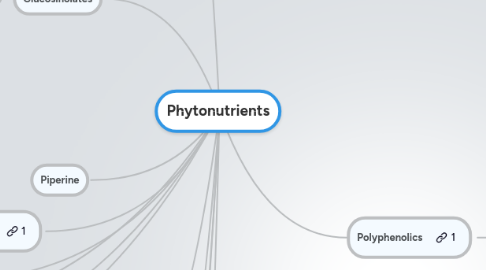
1. Terpenoids (isoprenoids)
1.1. Carotenoids Terpenoids
1.1.1. Carotenes
1.1.1.1. Beta Carotene
1.1.1.2. Alpha Carotene
1.1.1.3. Lycopene
1.1.1.4. Neurosporene
1.1.1.5. Phytofluene
1.1.1.6. Phytoene
1.1.2. Xanthophylls
1.1.2.1. Canthaxanthin
1.1.2.2. Beta Cryptoxanthin
1.1.2.3. Zeaxanthin
1.1.2.4. Astaxanthin
1.1.2.5. Lutein
1.1.2.6. Rubixanthin
1.2. Non-Carotenoid Terpenoids
1.2.1. Saponins
1.2.2. Triterpenoid
1.2.2.1. Oleanolic Acid
1.2.2.2. Ursolic Acid
1.2.3. Terpene Limonoids
1.2.3.1. Limonene
1.2.4. Perilly Alcohol
1.2.5. Terpeneol
2. Glucosinolates
2.1. Dithiolthiones (Isothiocyanates)
2.1.1. Sulphoraphane
2.1.1.1. Brassicates
2.2. Polysulfides (Allium Compounds)
2.2.1. Allyl Methyl Trisulfide
2.3. Indoles
2.3.1. Indole-3-carbinol
2.3.2. 3,3'-Diindolylmethane or DIM
2.3.3. Sinigrin
2.3.4. Allicin
2.3.5. Alliin
2.3.6. Allyl Isothiocyanate
2.3.7. Piperine
2.3.8. Syn-propanethial-S-oxide
2.4. Sulphides
2.4.1. Diallyl Sulfide
3. Piperine
4. Capsaicin
5. Pectin
6. Chlorophyll
7. Anthraquinones
8. Thiosulfonates
9. Betalains
9.1. Betacyanins
9.1.1. Betanin
9.1.2. Isobetanin
9.1.3. Probetanin
9.1.4. NeobBetanin
10. Phytosterols
10.1. Gama Sitosterol
10.2. Beta Sitosterol
10.3. Campesterol
10.4. Stigmasterol
11. Other Organic Acids
11.1. Oxalic Acids
11.2. Tartaric Acid
11.3. Anacardic Acid
12. Protein Inhibitors
12.1. Protease Inhibitors
13. Resources
13.1. Phytochemicals.info
13.2. List of phytochemicals in food by Wikipedia
13.3. Listing of Foods and their Phytochemicals by Phytopia
13.4. Tips to Fortify Foods with Phytochemicals
13.5. Glossary of Phytochemicals
13.6. Phytochemicals as Nutraceuticals by Ben Best
13.7. Linus Pauling Institute: Micronutrient Research for Optimum Health.
13.8. What is the Special Nutritional Power found in Phytonutrients?
14. Polyphenolics
14.1. Natural Monophenols
14.1.1. Apiole
14.1.2. Carnosol
14.1.3. Carvacrol
14.1.4. Dillapiole
14.1.5. Rosemarinol
14.2. Flavonoids (Polyphenols)
14.2.1. Flavonoids
14.2.1.1. Proanthocyanidins
14.2.1.1.1. Olignomeric Catechins
14.2.1.2. Biflavones
14.2.1.2.1. Amentoflavone, Bilobetin
14.2.1.3. Flavanonoles
14.2.1.3.1. Taxifolin
14.2.1.4. Flavonolignans
14.2.1.4.1. Silymarin
14.2.1.5. Tannins
14.2.2. Flavonols
14.2.2.1. Quercetin
14.2.2.2. Rutin
14.2.2.3. Kaempferol
14.2.2.4. Myricetinn
14.2.2.5. Isorhamnetin
14.2.3. Flavanones
14.2.3.1. Hesperidin
14.2.3.2. Naringin
14.2.3.3. Silybin
14.2.3.4. Eriodictyol
14.2.4. Flavanones
14.2.4.1. Apigenin
14.2.4.2. Tangeritin
14.2.4.3. Luteolin
14.2.5. Flavanols
14.2.5.1. Catechins
14.2.5.2. Epicatechins
14.2.5.3. Epigallocatechin Gallate (EGCG)
14.2.5.4. Theaflavin
14.2.6. Anthocyanins (Flavonals), and Anthocyanidins,
14.2.6.1. Cyanidin, delphinidin, Malvidin, Petunidin
14.2.6.2. Pelargonidin
14.2.6.3. Peonidin
14.2.6.4. Cyanidin
14.2.6.5. Delphinidin
14.2.6.6. Malvidin
14.2.6.7. Petunidin
14.2.7. Isoflavones (Phytoestrogens)
14.2.7.1. Diadzein
14.2.7.2. Genistein
14.2.7.3. Glycitein
14.2.8. Punicalagins
14.3. Phenolic Acids
14.3.1. Hydroxycinnamic Acids
14.3.1.1. Chicoric Acid
14.3.1.2. Coumarin
14.3.1.3. Ferullic Acid
14.3.1.4. Scopoletin
14.3.2. Hydroxybenzoic Acids
14.3.3. Rosmarinic Acid
14.3.4. Ellagic Acid
14.3.5. Gallic Acids
14.3.6. Vanillin
14.3.7. Salicylic Acid
14.3.8. Tannic Acid
14.3.9. Capsaicin
14.3.10. Curcumin
14.3.11. Hydroxycinnamic Acids
14.3.11.1. Chicoric Acid
14.3.11.2. Coumarin
14.3.11.3. Scopoletin
14.3.11.4. Caffeic Acid
14.3.11.5. Chlorogenic Acid
14.3.11.6. Coumarin Acid
14.3.12. Phytic Acid
14.3.13. Cinnamic Acid
14.3.14. Ferulic Acid
14.4. Other Non-Flavonoid Polyphenolics
14.4.1. Chicoric Acid
14.4.2. Coumarin
14.4.3. Ferullic Acid
14.4.4. Scopoletin
14.4.5. Curcumin
14.4.6. Stilbenes
14.4.6.1. Resveratrol
14.4.6.2. Pterostilbene
14.4.6.3. Piceatannol
14.4.7. Lignans (Phytoestrogens)
14.4.7.1. Silymarin
14.4.7.2. Matairesinol
14.4.7.3. Secoisolariciresinol
14.4.7.4. Pinoresinol and Lariciresinol
14.5. Tyrosol Esters
14.5.1. Class Members
14.5.1.1. Tyrosol
14.5.1.2. Hydroxytyrosol
14.5.1.3. Oleocanthal
14.5.1.4. Oleuropein

